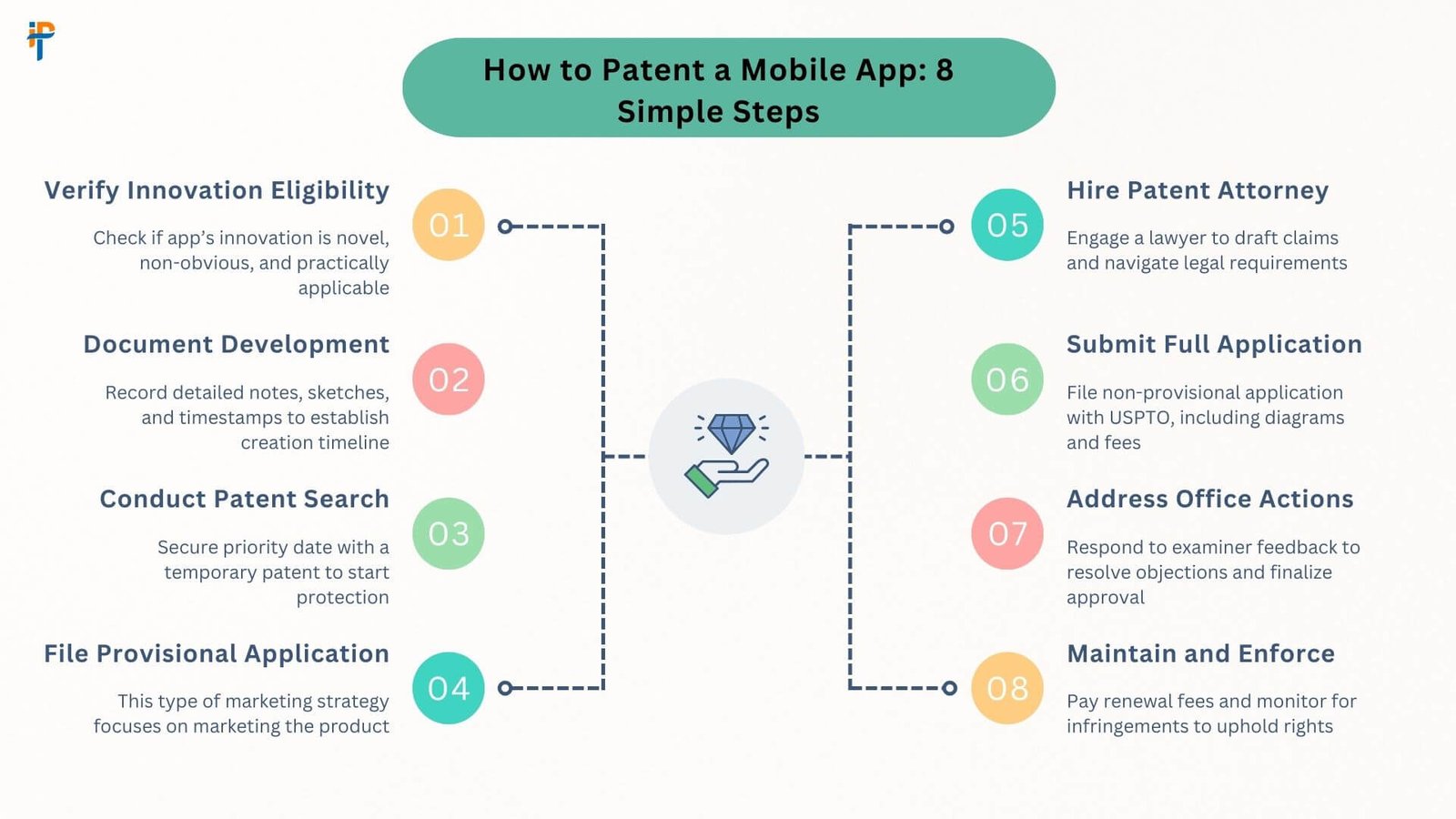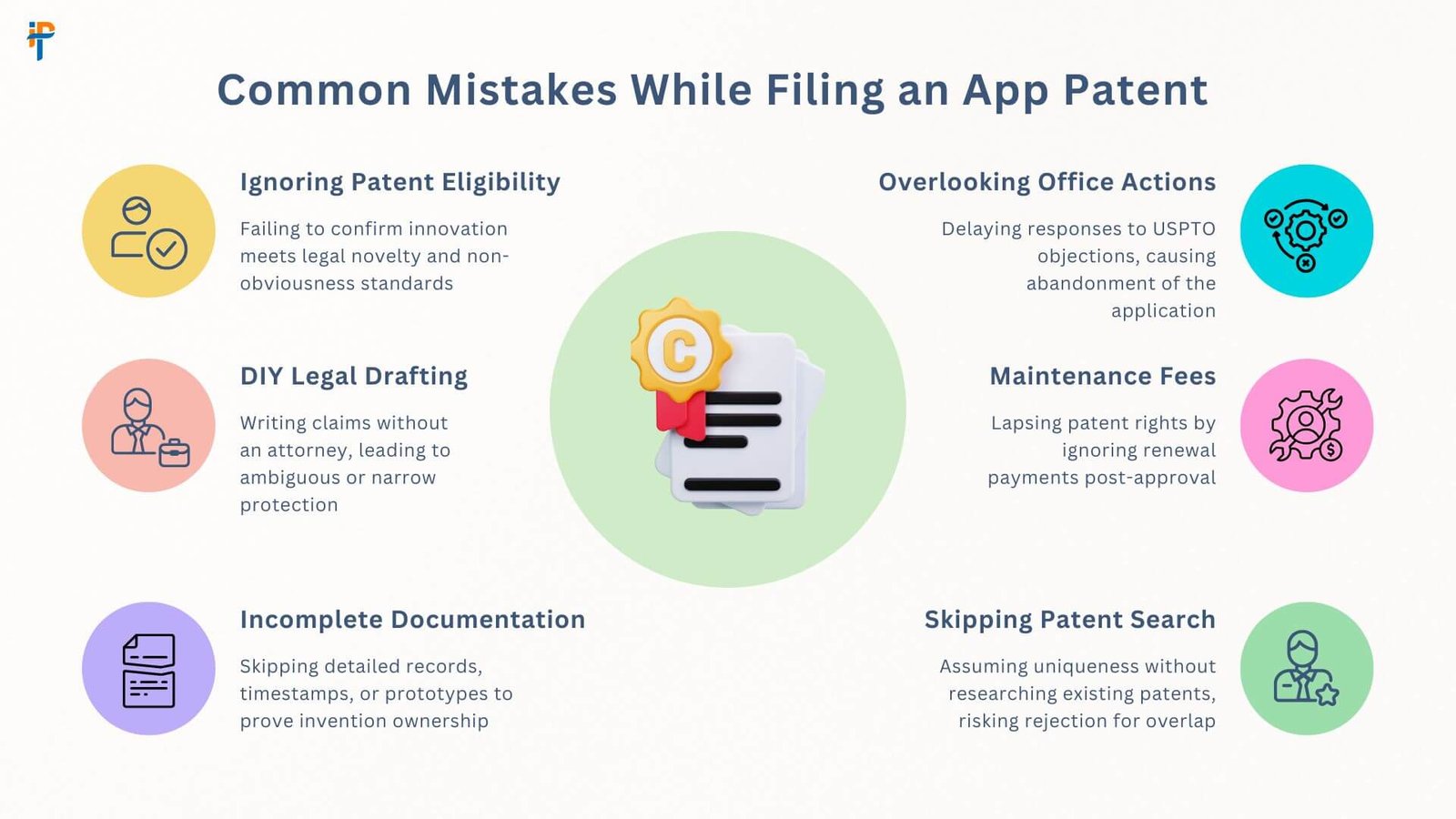How to Patent a Mobile App: The Complete Step-by-Step Guide in 2025
Introduction –
In 2023, over 200,000 software patents were filed—but guess what? 60% got rejected because people didn’t have the right paperwork or clear details. That’s a lot of wasted time and money.
If you are wondering how to patent a mobile app, you are in the right place. This article will inform you what to do, how not to get in trouble, and how much it will cost. You will learn how to guard the parts of your app that can be patented, how long it will take, and how to improve your odds for success.
Don’t worry—this won’t be loaded with legalese jargon. We will make it easy, straightforward, and useful. Let’s begin by ensuring that your great idea for the mobile app patent process remains yours!
What Parts of a Mobile App Can You Patent?
When you are learning how to patent a mobile app, it is important to know that not everything in your app can be protected. Let’s break it down into what can and can’t be patented.
Utility Patents for Functional Innovations
Let’s say you made something really smart in your app, like a cool new AI feature that talks to users in a special way, or a payment gateway that’s safer and faster than any other. These types of ideas are not just for fun. They actually do something useful. That’s where a utility patent comes in.
A utility patent protects how something works.
So if your mobile app uses a unique algorithm to find the best pizza places nearby or to help kids learn math in a new way, you can try to patent that idea. Just make sure it is not already out there and that it solves a real problem in a new way.
Example: You created an AI that learns your favorite songs and plays them before you ask. That’s a smart feature you might protect with a mobile app utility patent.
Also Read – How Much Does It Cost to Develop a Taxi App Like Hala?
Design Patents for UI/UX Elements
Now imagine your app doesn’t just work great, but it also looks awesome. If you have designed a special layout, fun icons, or cool screen transitions that make your app stand out, you might be able to patent a mobile app idea.
It covers the way something looks, not how it operates. So if you created really distinct icon design, a specific loading animation, or even custom gesture interactions (such as swiping two fingers to bring up a secret menu), you can attempt to patent it for that look.
Example: You made a rainbow swirl animation when users complete a level in your game. That could fall under a mobile app design patent.
Non‑Patentable Elements
Not everything in your mobile app can be patented. Some things are just too basic or too common. For example, if your app has a login screen that looks like every other app, or it just shows data in a plain list, that’s not new. Abstract ideas, simple data displays, and standard UI layouts do not qualify for patents.
Why? Because they are either too obvious or not original enough. Anyone can make a screen that says “Enter Username and Password.” That’s not considered a fresh invention.
Why can’t simple UI layouts be patented? Simple designs, like a basic login page or a plain settings menu, are used in almost every app. Since they are not special or unique, you can’t get a mobile app design patent for them.
Utility vs. Design Patent for Apps: Which One Do You Need?
When you’re ready to patent your idea, you will need to choose between:
- Utility patent: Protects how your app works (code, features, system)
- Design patent: Protects how your app looks (UI, layout, icons)
If you want to protect your app’s function, go for a utility patent. If it’s the visual style that makes your app special, a design patent might be enough. Sometimes, people apply for both.
How to Patent a Mobile App: 8 Simple Steps
Have a great mobile app idea? Want to make sure no one steals it? You’re not alone. Many people wonder how to patent a mobile app, but the process can feel confusing at first. Don’t worry — we are going to break it down into 8 simple steps you can follow, even if you’re just starting.
This guide uses clear language and walks you through the mobile app patent process step by step. Let’s get started!

Step 1: Make Sure Your App Can Be Patented
Before doing anything else, you need to see if your mobile app idea is patent eligible. Not all ideas can be patented. Your app must be:
- New (no one has done it before)
- Non-obvious (not something that anyone could easily think of)
- Useful (it must do something helpful)
To check this, the USPTO (United States Patent and Trademark Office) uses something called the Alice Test. This test helps figure out if the software is too abstract or if it has something special.
Quick Tip: Go to Google Patents and search for similar ideas. If you find something very close, your idea might not qualify.
Step 2: Do a Prior Art Search
Now it’s time to see if your idea already exists in any form. This is called a prior art search. You will want to search through older patents and documents to make sure you are not copying something by accident.
Great tools for this:
- USPTO Patent Center
- WIPO.int
- PatentlyO.com
Pro Tip: Use Boolean search terms like AND, OR, and NOT to narrow down results and find exactly what you need.
Step 3: Write Down Everything About Your App
This is a very important step. You need to document your invention completely. The more details you have, the better.
What to include:
- A list of what the app does
- Flowcharts showing how it works
- Diagrams like user flows or ER diagrams (Entity-Relationship diagrams)
- Pseudocode (fake code that shows how the app functions)
Alt text example: A simple mobile app user‑flow diagram that shows the steps users take inside your app.
Step 4: File a Provisional Patent (Optional)
If your idea is still in progress, or you’re not ready for a full patent yet, you can file a provisional patent.
- DIY cost: $70–$300
- Attorney cost: $2,000–$5,000
- Good news: This gives you 12 months to say your app is “patent pending.”
During this time, you can build, test, or pitch your idea without worrying about someone else filing it first.
Step 5: File a Non-Provisional Patent Application
This is the full patent application, and it’s required if you want legal protection for your app idea. The application must be detailed and include:
- Title
- Abstract (short summary)
- Claims (what makes your app unique)
- Specification (full explanation of how your app works)
- Drawings (visuals to help show the app’s design)
This is where things can get tricky. Many people who try to patent a mobile app idea on their own make mistakes with the claims section.
Step 6: Hire a Patent Attorney
Hiring a patent attorney is highly recommended. They know the rules, how to write strong claims, and how to protect their idea the right way.
Why hire an expert?
- DIY rejection rate is over 80%
- Rejections often happen due to vague or weak claims
A lawyer can help write the right words to show why your software is different. This can save you time and money in the long run.
Step 7: Respond to Office Actions
After you send in your application, the USPTO may send you an “office action.” This is a formal letter telling you if there are problems with your application.
Common reasons for rejection:
- They think the idea is too obvious
- They found prior art that’s too close to your idea
Don’t worry — you can still respond and amend your claims to explain why your app is different.
How-to: Amend Claims with Differentiating Language
You will need to amend your claims, which means updating the wording to better show what makes your app unique. You can do this by:
- Adding specific features your app has that others don’t have
- Explaining how your app solves a problem in a new way
- Using clear and detailed language to set your idea apart
Example: Instead of saying “a mobile app for scheduling,” you could say “a mobile app that uses AI to create personalized schedules based on user habits and real-time data.
Step 8: Maintain Your Patent
Even after your app gets a patent, your job isn’t done yet. You need to keep the patent active by paying maintenance fees to the USPTO (United States Patent and Trademark Office). These fees help keep your rights legally protected over the years.
Here is when and how much you need to pay:
At 3.5 years:
- Small entity: $800
- Micro entity: $400
- Large entity: $1,600
At 7.5 years:
- Small entity: $1,800
- Micro entity: $900
- Large entity: $3,600
At 11.5 years:
- Small entity: $3,700
- Micro entity: $1,850
- Large entity: $7,400
If you miss a payment, your software patent for apps could expire early, and someone else might legally use your idea.
Reminder: Log in to the USPTO Patent Center and set up email alerts so you don’t forget these important deadlines.
Also Read – How To Develop a Car Rental App Like Udrive in the UAE?
Costs, Timelines, and ROI of Patenting a Mobile App
If you are learning how to patent a mobile app, it’s important to understand the costs, timelines, and the possible return on investment (ROI). Patenting isn’t just about filling out forms — it’s a big part of the mobile app patent process and can help protect your idea and even increase your app’s value.
Quick Comparison: Provisional vs. Non-Provisional vs. Attorney Fees
| Type | Filing Time | Approval | Time Cost (DIY) | Cost (With Attorney) |
|---|---|---|---|---|
| Provisional Patent | 1–3 months | N/A (temporary) | $70–$300 | $1,000–$3,000 |
| Non-Provisional Patent | 3–6 months | 2–5 years | $400–$900 (filing) | $5,000–$15,000+ |
- A provisional patent for mobile apps is a lower-cost way to protect your idea while you build or test it. It gives you 12 months to file the full application.
- A non-provisional patent (often a utility patent) is what gets reviewed and approved by the USPTO.
- Working with a patent attorney for software raises your chances of approval, especially for complex apps.
Timeline to Patent a Mobile App Idea
- Provisional Patent: Can be filed in 1–3 months — great if you want fast “patent pending” status.
- Non-Provisional Patent: Takes around 2 to 5 years to get approved by the USPTO.
The mobile app patent process isn’t quick, but taking the right steps early can save you time later, especially if your app starts growing fast.
What’s the Real ROI?
Wondering if all this effort is worth it? Just look at what happened with Snapchat.
Snapchat patented its ephemeral messaging feature — the disappearing messages we all know. That one software patent for apps became a huge part of what made Snapchat different. Today, it’s a company worth over $24 billion.
Getting a patent helped Snapchat:
- Stand out in the app market
- Attract investors
- Protect its unique feature from being copied
That’s what a good patent can do.
Common Mistakes (And How to Fix Them)
When learning how to patent a mobile app, it is easy to make mistakes, especially if you are doing it yourself. Here are some of the most common errors people make during the mobile app patent process and how to fix them the smart way.

Mistake #1: Overbroad Claims
Many people write their patent claims too wide or too vague. The USPTO often rejects these because they don’t clearly show how the app is different from others.
Fix: Use precise technical terms. Be clear about what your app does and how it works. This is where a patent attorney for software can help by writing claims that are strong and detailed.
Mistake #2: Ignoring Global Markets
Maybe your app is just launching in your country, but what if it becomes popular worldwide? If you only file a patent in one country, others can copy your idea somewhere else.
Fix: File a PCT application (Patent Cooperation Treaty) to start protecting your app internationally. This is a smart move if you believe your app has global potential.
Mistake #3: Missing Deadlines
Even after you’ve filed a provisional patent for mobile apps or a full non-provisional one, the USPTO has strict deadlines. Missing one can lead to a rejected application or even losing your patent.
Fix: Use USPTO automated alerts to remind you when to file or respond. Set calendar reminders for key dates like fee payments, office action responses, or the 12-month deadline after filing a provisional patent.
Also Read – How Kotlin Multiplatform is Transforming Mobile App Development
Alternatives to Patents for App Protection
A patent is one strong way to protect your app, but it’s not the only way. If you are wondering about other ways to guard your idea, here are a few helpful tools:
Copyrights
Covers the code you wrote, as well as graphic elements like your app’s icons, layout, or animations. While this doesn’t stop others from making a similar app, it does stop them from copying your exact work.
Trademarks
Protects your app name, logo, and branding. This stops others from using names or logos that could confuse users.
Trade Secrets
This is useful if your app uses a unique algorithm or data analysis process. You don’t file anything publicly; instead, you protect it by keeping it confidential (like Coca-Cola’s secret formula). Use this when you can’t or do not want to file a patent.
These options can be combined with your software patent for apps strategy to keep your full product safe.
Conclusion
Knowing how to patent a mobile app is not always easy, but it is totally doable if you follow these simple steps. Remember, getting a patent takes time – think about 2 to 5 years for the complete non-provisional patent to be granted. But man, that’s a long time to have your idea protected and possibly become extremely wealthy, like Snapchat!
We also talked about common mistakes, so you can avoid those pitfalls. And don’t forget, while patents are super powerful, there are other ways to protect your app too, like understanding how to Copyright Software Code for your actual code or using trademarks for your app’s name and logo. For those who are also thinking about the infrastructure side of things, remember to look into Cloud Compliance Best Practices to ensure your app’s data and operations are secure and meet industry standards.













.png)


